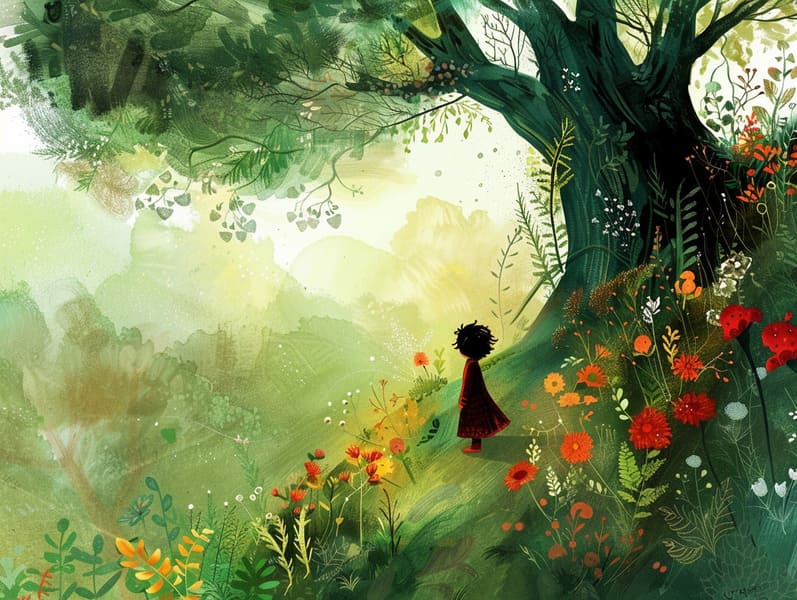The Journey of Children's Fairy Tales with the Consistent Wonder.
The Journey of Children's Fairy Tales with the Consistent Wonder.
Blog Article

Fairy tales for kids have deep roots. These narratives have been passed down from one generation to the next ages before they were ever put on paper. They originated from a variety of societies, including African traditions. They were initially conveyed among grown-ups, often carrying themes and messages relevant to the societal norms and beliefs of the time.
The Brothers Grimm, Jacob and Wilhelm (the Grimm brothers), were among the first to collect many of these beloved tales. Their published works, "Grimm's Fables," included narratives like "The Little Glass Slipper," "The Bread Crumb Trail," and "Snow-White and Rose-Red," which have since become cornerstones in the world of timeless fairy tales. Similarly, Andersen's fantastical fairy tales, such as "The Story of the Little Mermaid," and "The Little Duckling," have floated into hearts worldwide, ensuring their place in the pantheon of famous fairy tales.
Even though they are old, traditional fairy tales remain as relevant as ever, especially as bedtime stories for kids. These charming stories are now available in numerous formats, including artistically illustrated books, fantastical animations, and web-based fairy tales.
Their enduring popularity can be traced to several fascinating points:
Important Morals: Timeless fairy tales often illustrate important moral lessons. Fairy tales like "The Boy Who Cried Wolf" teach the virtue of truth, while "The Hare and the Tortoise" highlight the virtues of persistence and unassuming nature. These stories offer little ones clear distinctions between virtue and vice, guiding their moral compass in a soft yet significant way.
Compassion and Insight: Traditional fairy tales frequently feature protagonists facing challenges and struggles, inspiring readers to understand with their struggles and applaud their triumphs. For instance, "The Tale of Beauty and the Beast" shows us the virtue of valuing inner qualities to understand the real character of a person, building compassion and appreciation.
Cultural Appreciation: Many old fairy tales are imbued with the cultural contexts from which they were born. Engaging with these fairy tales can provide intriguing perspectives into different social structures, enhancing a sense of world insight and comprehension.
Inventiveness and Fantasy: The mythical elements in traditional fairy tales—talking beasts—inspire children’s inventiveness. These fairy tales guide readers to fantasy realms, activating innovative ideas and a sense of delight that persists a lifetime.
Classic fairy tales are not only entrancing but also didactic. They function as captivating tools in developing various brain and heart skills in young ones. When timeless fairy tales are narrated, they promote language acquisition by introducing new phrases and sophisticated sentence structures. This practice also nurtures hearing abilities and mental focus, as kids hang on every word, expectant to see what happens next.
Furthermore, examining the themes and characters of classic fairy tales can promote cognitive skills and thought processes. Young ones learn to identify patterns, make predictions, and catch on to cause and effect. These discussions also benefit children utter their thoughts and feelings, cultivating their emotional intelligence.
In today’s technological era, the availability of online storybooks has made these tales more reachable than ever. Online platforms and digital apps give broad selections of ancient fairy tales that can be explored or listened via anytime, anywhere. Fairy tales read aloud are particularly popular, sharing an delightful method for young readers to engage with these spellbinding stories. Narrated books and read-out-loud videos take characters and settings to life, often augmented by enchanting sound effects and music that enrich the storytelling journey.
The everlasting appeal of classic fairy tales lies in their ability to evolve to changing times while sustaining their core messages. Contemporary reinterpretations of these fairy tales often show more varied characters and modern settings, making them relatable to today’s audience. However, the fundamental themes of heroism, charity, and rightness remain unchanged, continuing to connect with listeners of all ages.
Ancient fairy tales also offer a sense of comfort and knowability. They impart a well-ordered narrative with a straightforward beginning, middle, and end, often winding up with the wrap-up of conflicts and the triumph of morality over immorality. This dependability can be consoling for little ones, making available a sense of unwaveringness in an shifting world.
Traditional fairy tales continue to entrance and enlighten new generations, maintaining their appeal and relevance in modern society. As children's night stories, they afford a perfect blend of captivation and insight, boosting moral values, empathy, and creativity. The existence of online fairy tales and the likability of fairy tales spoken certify that these ancient tales remain accessible to new generations.
By conserving and narrating these fairy tales, we continue to celebrate the rich tapestry of creativity and cultural heritage. Whether you are enjoying a beautifully illustrated book, perusing a cyber collection, or listening via an read-aloud book, the attraction of old fairy tales is always within reach. These tales demonstrate of the timeless power of fairy tales and its ability to link us click here across eras and regions.
Be it you are reading a richly illustrated book, delving into a digital collection, or playing an audio story, the beauty of ancient fairy tales is always within reach.
These tales convey of the continued nature of tales and its ability to bond us across epochs and places, establishing a link that enchants and educates alike.